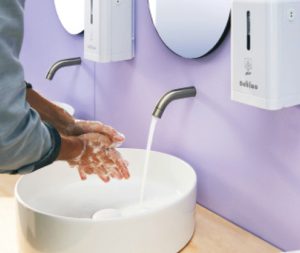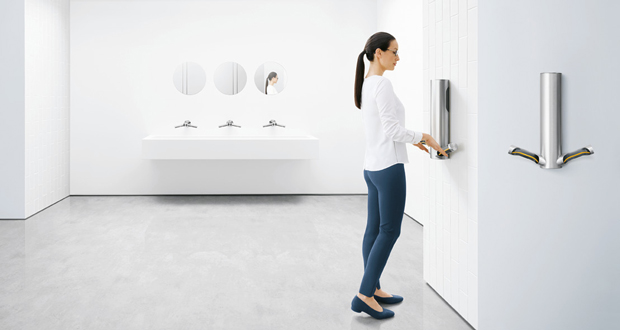A cross section of washroom product, services and consumable suppliers consider how FMs can maintain exemplary hygiene standards while meeting sustainability goals
Whether a public building, entertainment venue, reception or staff area, a site’s facilities will be slated if its washrooms are not properly maintained. And the role of the washroom is more important than ever since the pandemic, with a survey commissioned by Kimberly-Clark Professional (KCP) revealing that mindsets and attitudes towards hygiene and handwashing have shifted.
Says Craig Bowman, General Manager at Kimberly-Clark Professional in the UK: “The survey revealed present-day perceptions of cleanliness alongside evolving hygiene habits, expectations, and standards. For example, 76 per cent of respondents have had poor experiences with hand hygiene in public washrooms since the pandemic.”
The KCP report found a close second priority is the need for good quality products that are reliable, cost efficient and sustainable – and are good for us. Soaps and sanitisers that don’t dry out our hands but leave users feeling clean are important, as are facilities for quick but effective hand drying.
This is particularly important as we wash our hands far more often post-pandemic. A survey on washroom attitudes carried out by Dyson in 2021 found that 75 per cent of respondents were washing their hands five or more times a day. The report also revealed that effective hand drying was key to ensuring that clean hands stay clean. Wet hands can pick up more bacteria than dry ones, damp hands can transfer up to 1,000 times more bacteria than dry hands, while wiping hands on clothes can add bacteria to washed hands if the clothes aren’t clean.
Designing the washroom environment to operate as seamlessly as possible is a priority explains Paul Mulready, marketing manager at Northwood Hygiene Products: “We’re more informed about hotspots for germs and viruses and how  contaminated surfaces can harbour them, particularly in public spaces such as washrooms. Touchless fixtures, like touch-free taps, automatic soap dispensers, automatic paper towel dispensers, sensor operated dryers and automatic toilet flushes can help to reduce cross contamination and the spread of bacteria.”
contaminated surfaces can harbour them, particularly in public spaces such as washrooms. Touchless fixtures, like touch-free taps, automatic soap dispensers, automatic paper towel dispensers, sensor operated dryers and automatic toilet flushes can help to reduce cross contamination and the spread of bacteria.”
MAINTAINING WASHROOMS
Ensuring washroom consumables are regularly replenished and the area kept scrupulously clean is a must, says Alasdair Sharp, UK & Ireland Sales Manager at Satino by WEPA: “Positioning regularly updated cleaning rotas in plain sight, alongside the consistent upkeep of washrooms, including keeping soaps and papers fully stocked, allows facility managers to visibly express their care for their customers.”
Education amongst cleaning staff is also vital says Jonathan Weiss, Commercial Director at Reckitt: “During the pandemic, fogging and overcleaning are practices that became commonplace, which is ultimately counterproductive as it is wasteful of both the cleaning products and labour time. The excess of chemicals doesn’t actually make the space any cleaner and of course, isn’t great for the environment.”
“It’s for this very reason that we at Dettol Pro Solutions advocate for targeted hygiene solutions and invest in educational content, to make sure that products are being used correctly.
“Products and protocols should be used in hotspot areas that are frequently touched (e.g., doorknobs, bathroom fittings such as taps, door locks and toilet flush handles). For example, your bathroom faucet handle can have 21 times the bacteria of your toilet seat. Therefore, once cleaning and disinfection protocols are established, the critical element to reducing the potential for viruses and bacteria transmission is the timing and frequency of cleaning and disinfection.”
CONTROLLING COSTS
Given the cost-of-living crisis it’s important that the consumption of resources is where possible, controlled. Weiss advocates choosing refillable hygiene solutions such as dispensers, air fresheners and cleaning products so that waste levels are reduced.
Stuart Hands, Sales Manager of Essity Professional Hygiene also advises against opting for the cheapest possible systems such as loose paper towels, bulk-fill soaps and jumbo rolls or conventional toilet rolls.
“Loose hand towels on the units will promote over-consumption and people will be constantly dripping their wet hands on them, making them soiled and unusable. Bulk fill soaps can lead to messy sinks during the refilling process. And conventional toilet rolls may be placed on the floor or on the cistern where they will become soggy and contaminated.
“A dual roll toilet roll system in a locked dispenser is a hygienic alternative and will allow the cleaner to drop in a second roll at their own convenience to ensure a continuous supply. Soaps should be supplied in sealed cartridges that can be snapped quickly into place inside the dispenser. This will avoid the problems of messy units, wasted soap and potential contamination of the soap before use.”
Permanent fixtures should also be carefully chosen. KCP advises the use of LED lighting which can support the maintenance of hygiene without depleting resources. LED lights communicate when a unit needs attention to minimise time wasted and reduce touch points, for a more hygienic experience.





